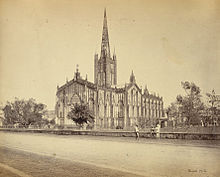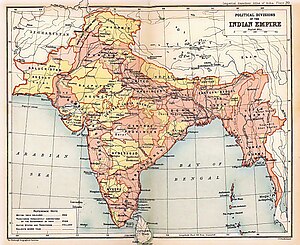Church of India, Burma and Ceylon
| Church of India, Burma and Ceylon (CIBC) Church of India, Pakistan, Burma and Ceylon (CIPBC) | |
|---|---|
 St. Paul's Cathedral in Calcutta (c. 1865) | |
| Classification | Protestant |
| Orientation | Anglican |
| Polity | Episcopal |
| Associations | Anglican Communion, World Council of Churches |
| Region | Indian Empire (1813-1947) North India & Pakistan (1947-1970) |
| Origin | 1813 |
| Separations | Church of South India (1947)[1] |
| Merged into | Church of North India (1970),[1] Church of Pakistan (1970)[1] |

The Church of India, Burma and Ceylon (CIBC) was the autonomous ecclesiastical province of the Anglican Communion, associated with the Church of England, in British India.[3]
The first Anglican diocese in India was established in 1813, the Diocese of Calcutta, which became the metropolitan see of the Church of India, Burma and Ceylon.[4] The Church of India, Burma and Ceylon spread as missionaries from the Church Mission Society travelled throughout the Indian Empire.[3] By 1930, the Church of India, Burma and Ceylon (CIBC) had fourteen dioceses across the Indian Empire.[2] Bishops from India were present at the first Lambeth Conference.[4]
After partition of India in 1947, the Church of India, Burma and Ceylon became known as the Church of India, Pakistan, Burma and Ceylon (CIPBC).[3] It published its own version of the Book of Common Prayer, which served as its authorised liturgical text.[1]
Later in 1947, four southern dioceses left the CIPBC and merged with South Indian Methodists and South Indian Presbyterians & Congregationalists to form the Church of South India.[1] In 1970, ecumenical dialogue led to the merger of the parts of the Church of India, Burma and Ceylon in India and Pakistan with other Protestant Christian denominations (including the Scottish Presbyterians, United Methodists and Lutherans), thus creating the Church of North India and Church of Pakistan, and to the creation of separate provinces of Sri Lanka and Burma.[4][3]
Dioceses of the CIBC
[edit]- Diocese of Calcutta (established in 1814)[2]
- Diocese of Madras (established in 1835)[2]
- Diocese of Bombay (established in 1837)[2]
- Diocese of Colombo (established in 1845)[2]
- Diocese of Lahore (established in 1877)[2]
- Diocese of Rangoon (established in 1877)[2]
- Diocese of Travancore (established in 1879)[2]
- Diocese of Chota Nagpur (established in 1890)[2]
- Diocese of Lucknow (established in 1893)[2]
- Diocese of Tinnevelly (established in 1896)[2]
- Diocese of Nagpur (established in 1903)[2]
- Diocese of Dornakal (established in 1912)[2]
- Diocese of Assam (established in 1915)[2]
- Diocese of Nasik (established in 1929)[2]
- Diocese of Delhi (established in 1947), carved from the Diocese of Lahore
- Diocese of Amritsar (established in1953), carved from the Diocese of Lahore
- Diocese of Barrackpore (established in 1956), carved from the Diocese of Calcutta
- Diocese of Andaman and Nicobar (established in 1966), from Diocese of Calcutta
Continuing CIPBC
[edit]Some elements in the CIPBC refused mergers with Lutherans, Presbyterians, Congregationalists, Methodists and Baptists as they did not wish to dilute Anglicanism. In 1948, part of the diocese of Nandyal opposed the union.[5] At the 1958 Lambeth Council, a resolution was passed to allow the Church of India, Pakistan, Burma, and Ceylon in Nandyal to manage their own affairs independently from the Church of South India.[6]
The Anglican Church of India under the Ecclesiastical Province of the Church of India, Pakistan and Ceylon as per decision of the General Council held on 2nd to 4th January 1970, under the Chairmanship of the Most Rev. Lac Desa De Mel at Calcutta. Many Anglicans had opposed the Church Union and did not follow its principles. The leaders who led the revival of the Anglican Church of India were staunch members of the Anglican Church. Some of the senior leaders of congregations were Andrew Prakash, E.D. Theophilus, Samuel P. Prakash, Robinson Paul, R.B. James, C.T. Gideon, Rev. E.J. Gideon, Ghulam Masih, Anderson Frank, Daniel Masih and some Anglican Priests were Rev. Jai Singh Thakore, Rev. John A. Prakash, Rev. Stanly Hague, and Rev. C.L. Prasad who had taken early retirement from their services and continued as Anglican Priests to serve Anglican congregations.[7]
In 1978, news of the Congress of St. Louis and the creation of the Anglican Catholic Church reached India. The Indian Anglicans appealed for a spiritual affiliation in the Anglican Catholic Church - Original Province. As a result, in 1983, Bishop John Asha Prakash was consecrated in California in United States. And subsequently in the year 1984 Bishop Samuel Peter Prakash son of John Asha Prakash along with Bishop Gideon from Calcutta and Bishop Rao from Amritsar. The consecration took place in WMCA, New Delhi. With these four dioceses the Province of India was restored and established as the Second Province of the Anglican Catholic Church. In 1989 The Diocese of Bombay consecrated Bishop Anselm Ranganadhan, and in 1996, the Diocese of Nagpur was restored and Bishop Francis Sylvestor consecrated there.[8]
Following the controversial consecrations in Deerfield Beach, Florida, the Titular Bishop of Calcutta and Metropolitan of India, Archbishop Louis Falk, left the Anglican Catholic Church in 1991. The Bishop of Delhi and Lucknow, John Prakash, and his son, Samuel Prakash, left as well, together with a number of clergy and congregations associated with Anthony Clavier, who had also been active in India. They formed the church known as the “Anglican Church of India”.[9] Samuel Prakash is currently the Metropolitan of the Anglican Church of India - CIPBC, which is a member of worldwide Traditional Anglican Church.
For the churches that remained in the Anglican Catholic Church, from 1991 until 1995 the late Archbishop William Lewis held office as Acting Metropolitan of India, later succeeded by Bishop James Bromley. Bishop Bromley appointed Samuel P Praksh as the Archdeacon and the Metropolitan’s Commissary to the Province of India. Bishop Rommie Starks succeeded Bishop Bromley as acting Metropolitan. In 2003, the Right Reverend Samuel P Praksh was elected and consecrated Bishop of Lucknow. In 2005, the Calcutta Diocesan Council and the House of Bishops elected the Right Reverend Samuel P Praksh as the Bishop of Calcutta and Metropolitan of India. The Most Reverend Samuel P Praksh was enthroned as Metropolitan of the Church of India-CIPBC on 24th February, 2005 at Christ Church, Lucknow.[8]
CIPBC rescinded Communion between 2014 and 2018 with the Anglican Catholic Church over matters relating to the status of the second province. In 2018, Archbishop Mark Haverland and Most Rev. Samuel P Praksh, Metropolitan of the CIPBC, signed an agreement restoring communio in sacris.[10]
See also
[edit]References
[edit]- ^ a b c d e Buchanan, Colin (4 August 2009). The A to Z of Anglicanism. Scarecrow Press. p. 234. ISBN 9780810870086.
On 27 September 1947, after conversations and negotiations lasting 28 years, and in the teeth of Anglo-Catholic opposition throughout the Anglican Communion, the four southern dioceses of CIPBC left the Anglican church and joined with South Indian Methodists and the South India United Church (itself the result of an earlier union of Presbyterians and Congregationalists) to become the Church of South India. The CIPBC synod authorized its own Book of Common Prayer (fairly closely related to the 1662 Book) in 1960. Negotiations continued towards united churches, and they came to fruition with the formation of the Church of Pakistan on 1 November 1970 and the Church of North India on 29 November 1970.
- ^ a b c d e f g h i j k l m n o p The Indian Year Book. Bennett, Coleman & Company. 1940. p. 455.
The three dioceses thus formed have been repeatedly subdivided, until in 1930 there were fourteen dioceses, the dates of their creation being as follows : Calcutta 1814; Madras 1835; Bombay 1837; Colombo 1845; Lahore 1877; Rangoon 1877; Travancore 1879; Chota Nagpur 1890; Lucknow 1893; Tinnevelly 1896; Nagpur 1903; Dornakal 1912; Assam 1915; Nasik 1929.
- ^ a b c d Dalal, Roshen (18 April 2014). The Religions of India: A Concise Guide to Nine Major Faiths. Penguin Books Limited. p. 177. ISBN 9788184753967.
- ^ a b c Tovey, Phillip (30 August 2017). Anglican Baptismal Liturgies. Canterbury Press. p. 234. ISBN 9781786220202.
The formation of united churches, particularly that of North India in 1970, led to the end of the Province.
- ^ Brown, L.W. "Three Years of Church Union" (PDF).
- ^ "The Lambeth Conference: Resolutions Archive from 1958" (PDF). p. 9.
- ^ "Introduction : Anglican Church of India". www.anglicanchurchofindia.com. Retrieved 2023-04-16.
- ^ a b "About The Church Of India". THE CHURCH OF INDIA - CIPBC.
- ^ Mercer, Bp. Robert. "Deerfield Beach Statement". www.anglicanchurchofindia.com. Retrieved 2023-04-16.
- ^ "COMMUNION TIES BETWEEN ACC, CIPBC RESTORED" (PDF). The Trinitarian. Jan–Feb 2018. p. 1. Archived from the original (PDF) on 2021-12-10. Retrieved 2021-12-10.
Further reading
[edit]- Weymont, M. E. (1973) The church of South India: progress, practice and problems 1960 to 1970, Durham theses, Durham University. Available at Durham E-Theses Online: http://etheses.dur.ac.uk/10023/
